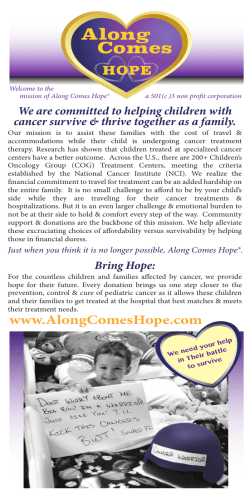
Corneal Transplantation and Donation Non-Communicable Diseases Watch Key Facts
Non-Communicable Diseases Watch October 2014 Corneal Transplantation and Donation Key Facts ※ Globally, visual impairment and blindness from corneal disease is a major ophthalmic public health problem. Various eye diseases and traumas can damage the shape and structure of the cornea, leading to corneal opacities and blindness. ※ For people who suffer from advanced corneal disease or corneal blindness, corneal transplantation (keratoplasty) is the only and most effective treatment to restore their vision. ※ In Hong Kong, cornea has become the most commonly transplanted tissue since the first successful corneal transplantation performed in 1961. However, the number of corneal donation falls far short of demand. ※ Most deceased individuals are in fact potential corneal donors. Age, blood type or eyesight qualities (such as short- or long-sighted) do not affect cornea donor’s suitability. Some cancer patients and Hepatitis B carriers are eligible corneal donors after death. Register as an Organ Donor ※ In Hong Kong, corneal transplantation depends on the voluntary corneal donation of a deceased person. People who wish to be an organ or tissue donor after death, please * Express your wish by registering in the Centralised Organ Donation Register (CODR). * Inform family and relatives about your wish. * Encourage family and relatives to do likewise. This publication is produced by the Surveillance and Epidemiology Branch, Centre for Health Protection of the Department of Health 18/F Wu Chung House, 213 Queen’s Road East, Wan Chai, Hong Kong http://www.chp.gov.hk All rights reserved Non-Communicable Diseases Watch October 2014 Corneal Transplantation and Donation The cornea is a clear dome-shaped surface that covers the front of the eye. Its main function is to refract and focus the light entering the eye. Microscopically, the cornea is composed of five major layers (including the epithelium, Bowman’s layer, stroma, Descemet’s membrane, and endothelium) which all have a specific function.1 If a cornea becomes damaged, scarred or cloudy, it can result in poor vision or blindness. In developed countries, non-infectious conditions tend to be more significant, such as keratoconus and corneal dystrophies.1, 4, 5 Of note, nearly 80% of all corneal blindness is avoidable. Prevention through public health interventions is clearly more costeffective than surgical intervention in reducing corneal blindness from trachoma, onchocerciasis and vitamin A deficiency, especially in developing countries.1 Epidemiology of Corneal Blindness Corneal Transplantation in Reducing Blindness Globally, visual impairment and blindness from corneal disease is a major ophthalmic public health problem.1 In 2010, corneal blindness accounted for approximately 10% of the 39 million blind worldwide.2 Various eye diseases and traumas can damage the shape and structure of the cornea, leading to corneal opacities and blindness (Box 1).1, 3 Major causes of corneal blindness vary across countries and populations. In developing countries, infectious diseases (including trachoma, onchocerciasis and leprosy), keratitis, traumas and use of traditional eye medicine with risk of contamination are the major causes of corneal blindness. For people who suffer from advanced corneal disease or corneal blindness, corneal transplantation (keratoplasty) is the only and most effective treatment to restore their vision.6 Corneal transplantation is a surgical procedure where a damaged or diseased cornea is replaced by donated corneal tissue in its entirety or in part. The graft tissue usually comes from deceased donors with no known diseases or other factors that affect the viability of the cornea. Box 1: Major causes of corneal opacities and blindness Infectious — e.g. bacterial, fungal or viral keratitis; trachoma; leprosy; onchocerciasis (river blindness) Trauma — e.g. penetrating trauma; chemical injuries or burns Nutritional — e.g. vitamin A deficiency Inflammatory — e.g. Stevens-Johnson Syndrome (a disorder of the skin that can also affect the eyes) Degenerative — e.g. keratoconus (a non-inflammatory eye condition in which the normally round cornea progressively becomes thin and cone-shaped) Inherited — e.g. Fuchs’ dystrophy (which occurs when corneal endothelial cells gradually deteriorate without any apparent reason) Congenital — e.g. Peters anomaly (which occurs in the early stages of foetal development and involves thinning and clouding of the cornea) Iatrogenic — e.g. misuse of traditional eye medicines or home remedies; complication from cataract surgery Page 2 Non-Communicable Diseases Watch October 2014 Worldwide, cornea is the most commonly transplanted tissue with about 100 000 procedures performed each year.1, 6, 7 In Germany, about 5 000 corneal transplantations were performed per year.8 In the United States, over 46 000 corneal transplantations were done in 2012.9 As the number of corneas grafted in the United Kingdom increased more than 50% from 2 364 in 2003/2004 to 3 615 in 2012/201310, the Eye Bank Association of Australia and New Zealand also recorded 34% increase in the number of corneal transplantations from 1 679 in 2009 to 2 250 in 2013.11 Improving quality and efficiency of eye banking, availability of trained corneal surgeons, advances in microsurgical techniques and better postoperative care of corneal grafts (such as efficient use of anti-inflammatory and immunosuppressive drugs) have collectively made corneal transplantation a very successful procedure.4, 12 Depending on the quality of the donor’s cornea, recipient corneal pathology, type of keratoplasty, surgical techniques and postoperative management of complications, the overall survival rate of corneal grafts in developed countries ranged from about 65% to 91% at 5 years and 59% to 82% at 10 years.4, 13 Even though corneal transplantation is a relatively safe procedure, it carries a small risk of complications. They include eye infection, swelling of the cornea, clouding of the eye’s lens (cataracts) and pressure increase within the eyeball (glaucoma). In some cases, graft rejection occurs that may require re-grafting.6 Corneal Transplantation and Donation in Hong Kong In Hong Kong, corneal transplantation depends on the voluntary corneal donation of a deceased person. Since the first successful corneal transplantation performed in 1961, cornea has become the most commonly transplanted tissue in Hong Kong. However, the number of corneal donation falls far short of demand with an annual average of about 220 donated cornea pieces over the past decade (Figure 1). As at 31 December 2013, there were 500 patients waiting for corneal transplantation.14 Overseas studies showed that shortage of donated corneas and difficulty in obtaining consent for corneal donation could be attributed to a number of factors. Barriers to corneal donation included superstitious sentiments or misconceptions about eye donation, lack of awareness or knowledge of corneal donation, and family opposition to the idea of organ or tissue donation.15-17 Number of cornea donated (piece) Figure 1: Number of corneal donation (piece) between 1 January 2004 and 31 December 2013 300 230 250 244 214 198 200 211 259 238 248 203 100 0 2004 2005 2006 2007 2008 2009 2010 2011 2012 2013 Year Source: Hospital Authority Lions Eye Bank. Page 3 Non-Communicable Diseases Watch October 2014 Corneal Donation: The Gift of Sight In fact, most deceased individuals are potential corneal donors. Unlike solid organ or other tissue donation, blood type does not affect cornea donor’s suitability. It is because the cornea is not nourished by blood, which means no matching is required. Similarly, age is not a barrier so that people below 80 years old can be a corneal donor.18 Studies observed that the 5-year success rate was the same – 86% – for transplantations performed with corneas from donors aged 12–65 years and from donors aged 66–75.19 Some people may have the misconception that since they wear eyeglasses, their eyes would be unsuitable for donation. This is not so. Eyesight quality (such as short- or long-sighted) does not affect the suitability for corneal donation, but donors should have no history of corneal disease or trauma. Cancer patients can be eligible for corneal donations after death, provided they do not have lymphoma, leukaemia, myeloma, and malignant tumors of ocular or periocular area. While people with severe infections or communicable diseases (such as HIV/AIDS and hepatitis) are not suitable for corneal donation, hepatitis B carriers can donate their corneas to corneal patients who are also hepatitis B carriers.18 Same as organ donation procedures, corneal retrieval does not cause disfigurement of the donor’s face or delay the funeral. Corneal (and organ) donation will not make medical personnel offer less treatment, and there is no cost to donors or their families for organ or tissue donation. Besides, major religions do support organ donation, regarding it as the final act of love and generosity towards others. Register as an Organ Donor Organ and tissue donation is a charitable act and may save or improve lives of transplant receivers. If people wish to be an organ or tissue donor after death, they can express their wish by registering in the Centralised Organ Donation Register (CODR). Compared to simply carrying an organ donation card, the CODR will more reliably record the will of the donors. Moreover, authorised personnel responsible for organ donation may access the CODR upon the donors’ death to know about their wish of donating organs (Box 2). Box 2: For those prospective organ donors who wish to register their wish in the Centralised Organ Donation Register (CODR), they can: 1) Register online at https://www.codr.gov.hk/codr/Internet.do ; or 2) Download and complete the organ donation registration form, and send it to the CODR System Administrator by post or fax. By post: CODR System Administrator, Department of Health, 21/F, Wu Chung House, 213 Queen’s Road East, Wan Chai, Hong Kong By fax: 2127 4962 For enquiries concerning the CODR, please call 2961 8441 or email to codr@dh.gov.hk. Page 4 Non-Communicable Diseases Watch October 2014 Prospective organ and tissue donors should also inform family and relatives about their wish to donate organs and tissue after death. In Hong Kong, expressed consent from family or relatives of a prospective donor is required prior to organ and tissue retrieval. So if the family or relatives are unaware of their loved ones’ honourable intent to donate organ and tissue after death, they may prohibit organ and tissue harvesting. Prospective organ and tissue donors can also encourage family and relatives to do likewise. To know more about organ donation and relevant promotional activities in Hong Kong, please visit http://www.organdonation.gov.hk. 16. Lawlor M, Kerridge I, Ankeny R, et al. Specific unwillingness to donate eyes: the impact of disfigurement, knowledge and procurement on corneal donation. Am J Transplant 2010; 10(3):657-63. 17. Yew YW, Saw SM, Pan JC, et al. Knowledge and beliefs on corneal donation in Singapore adults. Br J Ophthalmol 2005; 89(7):835-40. 18. Organ Donation - Know More about Organ Donation (What is Corneal Transplantation?). Hong Kong SAR: Department of Health, 2013. 19. Gal RL, Dontchev M, Beck RW, et al. The effect of donor age on corneal transplantation outcome results of the cornea donor study. Ophthalmology 2008; 115(4):620-6. References 1. Lamm V, Hara H, Mammen A, et al. Corneal blindness and xenotransplantation. Xenotransplantation 2014; 21:99-114. 2. Global Data on Visual Impairment 2010. Geneva: World Health Organization, 2012. 3. Burton MJ. Corneal blindness. Prevention, treatment and rehabilitation. Comm Eye Health 2009; 22(17):33-5. 4. Garg P, Krishna PV, Stratis AK, Gopinathan U. The value of corneal transplantation in reducing blindness. Eye (Lond) 2005; 19(10):1106-14. 5. Sinha R, Sharma N, Vajpayee RB. Corneal blindness - present status. Cataract Refract Surg Today 2005; 10(59-61). 6. Tan DT, Dart JK, Holland EJ, Kinoshita S. Corneal transplantation. Lancet 2012; 379(9827):1749-61. 7. Davari M, Amini A. Clinical indications of penetrating keratoplasty: an epidemiological study in teaching hospital of Birjand. Iranian J Ophthal 2008; 20(4):30-3. 8. Corneal Transplantation. Munich: Hornhautbank Munchen, 2013. 9. 2012 Eye Banking Statistical Report. Washington, D.C.: Eye Bank Association of America, 2013. 10. Organ Donation and Transplantation. Activity Report 2012/13. England: NHS Blood and Transplant. 11. Corneal Donations and Outcome Data. Eye Bank Association of Australia and New Zealand, 2014. 12. Young AL, Kam KW, Jhanji V, et al. A new era in corneal transplantation: paradigm shift and evolution of techniques. Hong Kong Med J 2012; 18(6):509-16. 13. Weinberg MA, Insler MS, Dussetschleger FL, Insler A. Corneal transplantation. US Pharm 2011; 36(4):HS-19-HS-27. 14. Organ Donation - Statistics. Hong Kong SAR: Department of Health. 15. Lawlor M, Kerridge I. Anything but the eyes: culture, identity, and the selective refusal of corneal donation. Transplantation 2011; 92(11):1188-90. Page 5 Non-Communicable Diseases Watch October 2014 Data Brief A telephone survey conducted by the Department of Health (DH) of over 2 100 community-dwelling people aged 18 – 64 in 2013 showed that overall 63.4% respondents were willing to donate their organs after death. Female respondents, those who were never married, managerial/professional workers and those living in private housing were more likely than their respective counterparts to report that they were willing to donate organs after death. Also, the younger, the higher the educational attainment and the higher the monthly household income of the respondents, the more likely they reported so. A successful organ donation programme greatly relies on community support. DH will continue working closely with various community partners in promoting such philanthropic spirit of giving. Rate of community-dwelling people aged 18 – 64 reported that they were willing to donate organs after death by demographic characteristics Gender Age Group • Female 64.5% • 18 – 24 77.1% • Male 62.2% • 25 – 34 73.7% • 35 – 44 66.8% Marital Status • Never married 74.1% • 45 – 54 57.4% • Married 58.8% • 55 – 64 49.5% • Divorced/Separated/Widowed 53.1% Occupation Educational Attainment • Tertiary (non-degree, degree or above) 71.4% • Managerial/Professional worker 75.3% • Upper secondary (F.4 – F.6)/Matriculation 65.6% • Clerk 67.8% • Lower secondary (F.1 – F.3) 54.3% • Service/Shop sales worker 62.2% • Primary or below 38.6% • Blue collar worker 53.2% • Not working 59.3% Type of Living Quarters Monthly Household Income • $40,000 or above 75.1% • $20,000 – $39,999 66.1% • Private housing 67.0% • $14,000 – $19,999 63.0% • Subsidized sale flats 63.1% • $8,000 – $13,999 53.3% • Public rental flats 57.3% • Below $8,000 46.5% Note: Excluding respondents with missing information in respective groups. Source: Behavioural Risk Factor Survey, April 2013. Editor-in-Chief Non-Communicable Diseases (NCD) WATCH is dedicated to promote public’s awareness of and disseminate health information Dr Regina CHING Members about non-communicable diseases and related issues, and the importance of their prevention and control. It is also an indication of Dr Thomas CHUNG Mr YH LEE our commitments in responsive risk communication and to address Dr Cecilia FAN Dr Eddy NG Dr Anne FUNG Dr Karen TSO Ms Janice HO Dr Lilian WAN Dr Winnie LAU Dr Monica WONG Dr Ruby LEE Dr Priscilla WONG the growing non-communicable disease threats to the health of our community. The Editorial Board welcomes your views and comments. Please send all comments and/or questions to so_dp3@dh.gov.hk. Page 6
© Copyright 2025









